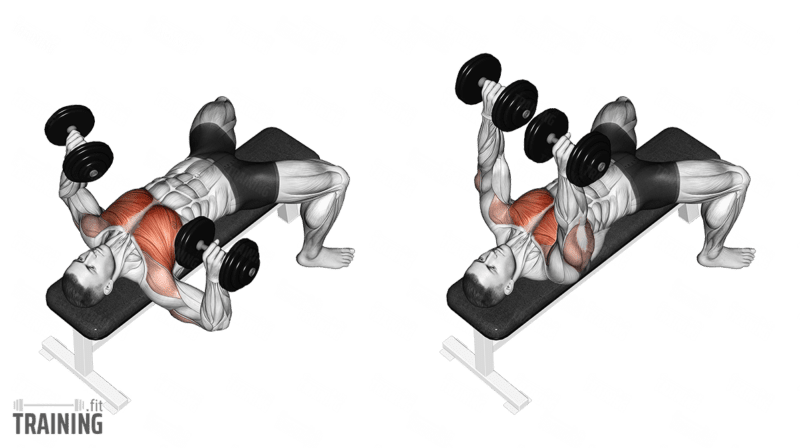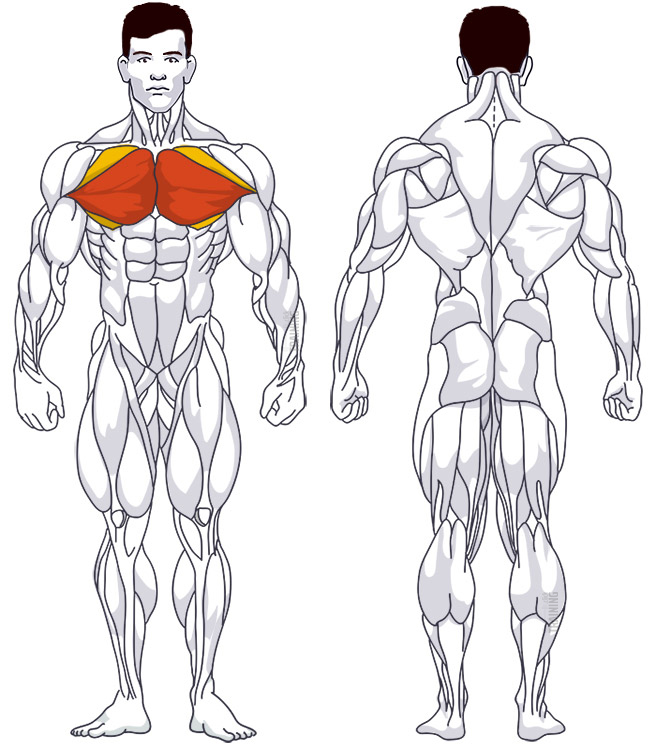Dumbbell Bench Press
Compound exercise, Free weightsOverview

Main muscles
- Chest: Large pectoral muscle
(Musculus pectoralis major) - Chest: Small pectoral muscle
(Musculus pectoralis minor)
Training plans
Here you can find example plans for dumbbell bench press training:
Dumbbell Bench Press: Basics and alternatives

Involved main muscle groups:
Dumbbell Bench Press
Dumbbell bench press is a popular alternative to the barbell bench press. This exercise allows for a less restricted range of motion while still maintaining the same basic movement, making it a favorite variation among many athletes. You’ll be lying on a flat bench and pressing two dumbbells vertically upward with both arms. It’s a compound exercise, targeting multiple muscle groups, with the primary focus on the middle chest.
As alternatives to barbell variations, you can also try decline dumbbell bench press or incline dumbbell bench press. Additionally, flys, machine chest flys, or the chest press are often chosen to supplement chest muscle training.
Correct execution
The dumbbell bench press follows the same rules as the barbell version, with the main difference being arm movement. With a barbell, your arm and shoulder movement is more restricted. Using dumbbells allows for a more natural and larger range of motion.
However, this also means your weaker side won’t be compensated for by the other one. This can be an advantage, as it forces you to train more evenly. But it can also be a disadvantage, as you may need to use less weight and concentrate more during the exercise.
Beginners should be aware that the bench press may not always be noticeable in the chest area at first. This applies to both barbell and dumbbell variations. Other muscle groups (triceps and shoulder) act as bottlenecks to the primary activation of the chest. However, this issue usually resolves itself over time.
Video tutorial
Step-by-step instructions
Grab the dumbbells and sit on the flat bench. Place the dumbbells just above your knees on your thighs.
Lie on your back on the bench and simultaneously push the dumbbells up with your knees to bring them directly over your chest (see video above).
Keep your feet firmly on the ground and press the dumbbells up side by side with your arms extended above your chest. The backs of your hands should face your head.
Pull your shoulder blades back.
Form a slight arch in your back, creating the so-called bridge. This helps you manage the pushing movement coming from the chest optimally. You’re now in the starting position.
Slowly lower the dumbbells by bending your elbows and pulling your shoulders back. Your elbows shouldn’t be spread too far outwards, but should be directed inward, towards your body. Keep your shoulder blades contracted the entire time.
Stop the downward movement when your chest is stretched or your upper arms are about parallel to the floor.
Push the dumbbells back up through your chest to the starting position by straightening your shoulders and elbows and moving your arms in front of your chest.
Common mistakes
Incorrect shoulder posture is a common issue that can significantly reduce the chest training stimulus. Make sure to keep your shoulder blades contracted throughout the exercise and push the weight through your chest.
Elbow position is also important: Your elbows should not be spread too wide, but also shouldn’t be too close to your body. The ideal position depends on your personal physique. Experiment to find the best possible position for the greatest activation of your chest muscles.